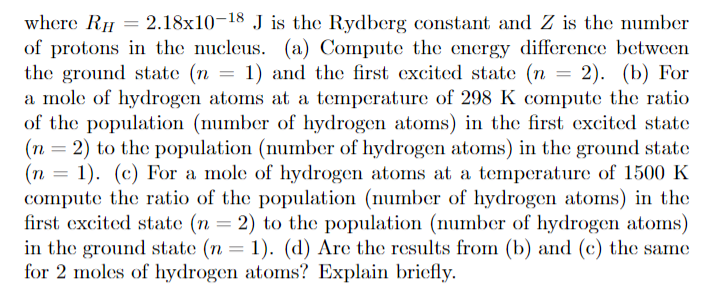where RH 2.18x10-18 J is the Rydberg constant and Z is the number of protons in the nucleus. (a) Compute the energy difference between the ground state (n a mole of hydrogen atoms at a temperature of 298 K compute the ratio of the population (mumber of hydrogen atoms) in the first excited state (n 2) to the population (number of hydrogen atoms) in the ground state (n 1. (c) For a mole of hydrogen atoms at a temperature of 1500 K compute the ratio of the population (number of hydrogen atoms) in the first excited state (n = 2) to the population (number of hydrogen atoms) in the ground state (n = 1). (d) Are the results from (b) and (c) the same for 2 moles of hydrogen atoms? Explain briefly 1) and the first excited state (n 2). (b) For
where RH 2.18x10-18 J is the Rydberg constant and Z is the number of protons in the nucleus. (a) Compute the energy difference between the ground state (n a mole of hydrogen atoms at a temperature of 298 K compute the ratio of the population (mumber of hydrogen atoms) in the first excited state (n 2) to the population (number of hydrogen atoms) in the ground state (n 1. (c) For a mole of hydrogen atoms at a temperature of 1500 K compute the ratio of the population (number of hydrogen atoms) in the first excited state (n = 2) to the population (number of hydrogen atoms) in the ground state (n = 1). (d) Are the results from (b) and (c) the same for 2 moles of hydrogen atoms? Explain briefly 1) and the first excited state (n 2). (b) For
Chemistry: The Molecular Science
5th Edition
ISBN:9781285199047
Author:John W. Moore, Conrad L. Stanitski
Publisher:John W. Moore, Conrad L. Stanitski
Chapter5: Electron Configurations And The Periodic Table
Section: Chapter Questions
Problem 120QRT
Related questions
Question
last three subparts

Transcribed Image Text:where RH 2.18x10-18 J is the Rydberg constant and Z is the number
of protons in the nucleus. (a) Compute the energy difference between
the ground state (n
a mole of hydrogen atoms at a temperature of 298 K compute the ratio
of the population (mumber of hydrogen atoms) in the first excited state
(n 2) to the population (number of hydrogen atoms) in the ground state
(n 1. (c) For a mole of hydrogen atoms at a temperature of 1500 K
compute the ratio of the population (number of hydrogen atoms) in the
first excited state (n = 2) to the population (number of hydrogen atoms)
in the ground state (n = 1). (d) Are the results from (b) and (c) the same
for 2 moles of hydrogen atoms? Explain briefly
1) and the first excited state (n
2). (b) For
Expert Solution
This question has been solved!
Explore an expertly crafted, step-by-step solution for a thorough understanding of key concepts.
This is a popular solution!
Trending now
This is a popular solution!
Step by step
Solved in 4 steps with 3 images

Knowledge Booster
Learn more about
Need a deep-dive on the concept behind this application? Look no further. Learn more about this topic, chemistry and related others by exploring similar questions and additional content below.Recommended textbooks for you

Chemistry: The Molecular Science
Chemistry
ISBN:
9781285199047
Author:
John W. Moore, Conrad L. Stanitski
Publisher:
Cengage Learning

Principles of Modern Chemistry
Chemistry
ISBN:
9781305079113
Author:
David W. Oxtoby, H. Pat Gillis, Laurie J. Butler
Publisher:
Cengage Learning

Chemistry: Principles and Practice
Chemistry
ISBN:
9780534420123
Author:
Daniel L. Reger, Scott R. Goode, David W. Ball, Edward Mercer
Publisher:
Cengage Learning

Chemistry: The Molecular Science
Chemistry
ISBN:
9781285199047
Author:
John W. Moore, Conrad L. Stanitski
Publisher:
Cengage Learning

Principles of Modern Chemistry
Chemistry
ISBN:
9781305079113
Author:
David W. Oxtoby, H. Pat Gillis, Laurie J. Butler
Publisher:
Cengage Learning

Chemistry: Principles and Practice
Chemistry
ISBN:
9780534420123
Author:
Daniel L. Reger, Scott R. Goode, David W. Ball, Edward Mercer
Publisher:
Cengage Learning

Chemistry: Principles and Reactions
Chemistry
ISBN:
9781305079373
Author:
William L. Masterton, Cecile N. Hurley
Publisher:
Cengage Learning

Chemistry: An Atoms First Approach
Chemistry
ISBN:
9781305079243
Author:
Steven S. Zumdahl, Susan A. Zumdahl
Publisher:
Cengage Learning

Chemistry
Chemistry
ISBN:
9781305957404
Author:
Steven S. Zumdahl, Susan A. Zumdahl, Donald J. DeCoste
Publisher:
Cengage Learning